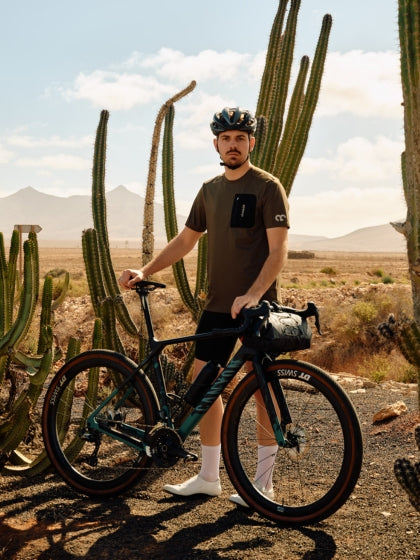The onion principle for temperature management on the bike
When the thermometer drops again at the end of summer, it is particularly important to brave the cooler wind and at the same time not to overheat when you pedal. The onion look offers the perfect solution here.
Baselayer as the first layer
You should choose a base layer as your first layer of clothing. This tight-fitting undershirt hugs your upper body with its soft functional fibers and ensures that sweat is wicked directly away from the body. Accordingly, the base layer should fit really tightly and not create any unnecessary wrinkles ( Baselayer Men , Baselayer Women ).
The next layer is the long-sleeved jersey
Long-sleeved jerseys are usually made from functional fibers with a solid membrane. They keep you warm even in cooler weather conditions and are still breathable. A body-hugging cut also ensures that you move aerodynamically through the wind. Three back pockets and an additional lockable back pocket offer you enough storage space for money and keys. Depending on your own temperature sensitivity, non-tiled long-sleeved jerseys are suitable for cycling between 10° and 16°. Reflective elements on the chest and back provide additional safety on darker days ( Aerlig Longsleeve Men , Aerlig Longsleeve Women ).
 Arm and leg warmers keep you warm
Arm and leg warmers keep you warm
If you prefer a short cycling jersey in moderate temperatures, combine it with arm warmers. These practical accessories reliably protect you from wind and UV rays and can be easily removed and stored in the back pocket of your jersey when temperatures rise or you exert yourself more heavily. Usually you first pull arm warmers up to your upper arm and then pull the sleeves of the jersey down again (arm warmer).
 With the multi-layer principle, the first layer for the legs should of course not be missing. Ergonomically shaped leg warmers made from functional fibers are wind-resistant and keep your lower extremities warm. As with the arm warmers, the leg warmers are first pulled up to the thigh and the bib shorts are then slipped over the leg warmers. Whether the leg warmers are worn over or under the cycling socks is purely a personal preference. If necessary, the leg warmers can simply be removed (leg warmer).
With the multi-layer principle, the first layer for the legs should of course not be missing. Ergonomically shaped leg warmers made from functional fibers are wind-resistant and keep your lower extremities warm. As with the arm warmers, the leg warmers are first pulled up to the thigh and the bib shorts are then slipped over the leg warmers. Whether the leg warmers are worn over or under the cycling socks is purely a personal preference. If necessary, the leg warmers can simply be removed (leg warmer).
Aero bib shorts for the seamless look
In combination with the leg warmers, bib shorts can easily be worn even in cooler weather, as your legs do not cool down as quickly due to movement. Thanks to the seamless design of our bib shorts, the leg warmers fit perfectly into your minimalist cycling outfit (Aero Bib Shorts Men , Aero Bib Shorts W omen ).
The third layer with a windbreaker or wind vest
Windproof windbreakers or wind vests are suitable for thermal insulation. A wind-protected front keeps out the cold wind and protects you from getting cold. At the same time, a breathable mesh fabric on the back ensures that moisture can escape in a targeted manner. A high collar keeps the sensitive neck area warm, and an extended back section offers you additional weather protection. You should always carry a windbreaker or wind vest with you in changeable weather. With their small pack size, they can be easily stored in the back pocket of your (long-sleeved) jersey. Windbreakers and wind vests are suitable for temperatures from <14° ( windbreaker men , windbreaker women , wind vest men , wind vest women ).
Conclusion - the right cycling clothing for the transitional period
You shouldn't miss out on your bike rides, even in the cooler seasons. With the right cycling clothing, you are well protected against cold and wet thanks to the different layers.
First layer:
- Base layer (undershirt)
- Arm warmers (for short-sleeved jerseys)
- Leg warmers
- Cycling socks
Second layer:
- Long sleeve jersey or
- Short sleeve jersey
- Bib shorts
Third layer (at temperatures <14°):
- Windbreakers
- Wind vest
Ready for the optimal combination of your layers in a matching, minimalist design? Then discover our bundles now.




















